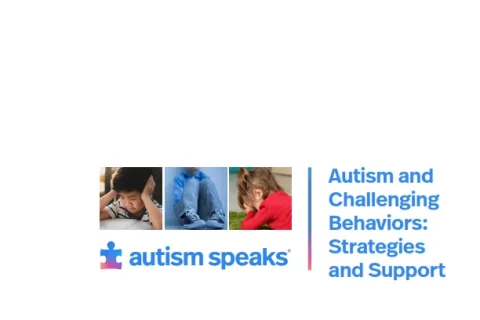Helpful strategies to promote positive behavior
Challenging Behaviors Tool Kit
It is important to develop strategies for you to use to increase the behaviors you want to see in your child. These will need to be individualized to his particular needs and challenges. They can often be helpful in building a sense of pride in accomplishments and personal responsibility, and a sense of what is expected. This will reduce the anxiety and reactivity that results in aggression or other behaviors.
Autism behavior support and strategies
- Celebrate and build strengths and successes: Tell him what he does well and what you like. A sense of competence often fosters interest and motivation. Strive to give positive feedback much more frequently than any correction or negative feedback. ‘Great job putting your dishes in the sink!’
- Respect and listen to him: You may have to look for the things he is telling you, verbally or through his choices or actions. ‘You keep sitting on that side of the table. Is the sun in your eyes over here?’
- Validate his concerns and emotions: Do not brush aside his fears or tell him not to worry. His emotions are very real. Help to give language to what he is feeling. ‘I know you do not like spiders. I can see that you are very afraid right now.’ ‘I can see that you are angry that our plans have changed.’
- Provide clear expectations of behavior: Show or tell your child what you expect of him using visual aids, photographs or video models. A great way to teach new skills is Tell-Show-Do.
- Set him up for success: Provide accommodations. Accept a one word answer instead of demanding a whole sentence. Use a larger plate and offer a spoon to allow him to be neater at the dinner table. Use Velcro shoes or self-tying laces if tying is too frustrating.
- Ignore the challenging behavior: Do your best to keep the challenging behavior from serving as his way of communicating or winning. This is hard to do, but in the long run it is effective. Do not allow his screams to get him out of brushing his teeth, or his biting to get him the lollipop that he wants. Behaviors may get worse before you start to see them get better. Stay the course! And make sure all family and team members are consistent in this approach and that you pair this with other positive strategies.
- Alternate tasks: Do something that is fun, motivating or that your child is good at. Then try something hard. He will be less inclined to give up or get agitated if he is already in a positive framework.
- Teach and interact at your child’s or loved one’s learning level: Take care to set him up for growth and accomplishment, rather than the anxiety produced by constant failure or boredom.
- Give choices, but within parameters: Everyone needs to be in control of something, even if it is as simple as which activity comes first. You can still maintain some control in the choices that you offer. ‘Do you want to eat first, or paint first?’
- Provide access to breaks: Teach the individual to request a break when he needs to regroup (e.g. use a PECS card that represents “break”). Be sure to provide the break when he asks so he learns to trust this option and does not have to resort to challenging behaviors.
- Promote the use of a safe, calm-down place: Teach him to recognize when he needs to go there. This is a positive strategy, not a punishment.
- Set up reinforcement systems: Use simple, predictable processes that reward your child for desired behavior. Catch him being good and reward that, verbally and with favored activities, objects or ‘payment.’ ‘I love that you stayed with me during our shopping trip. You earned a ride on the airplane toy!’
- Allow times and places for him to do what he wants: Even if it is a ‘stim’, it is important to provide these options when it is not an intrusion or annoyance to others.
- Reward flexibility and self control: ‘I know you wanted to go to the pool today and we were surprised when it was closed. For staying cool and being so flexible about that change in plans, let’s go get some ice cream instead!’
- Pick your battles: Strive for balance. Focus on the behaviors and skills that are most essential. Be sure to include positive feedback and intersperse opportunities for success and enjoyment for you, your family, and your loved one with autism. Be resilient. Celebrate the fun and the good things!
- Use positive/proactive language: Use language that describes what you want the individual to do (e.g. ‘I love how you used a tissue!’), and try to avoid saying ‘NO’, or ‘don’t’ (e.g. ‘stop picking your nose.’).
Read more in the Autism Speaks Challenging Behaviors Tool Kit.






